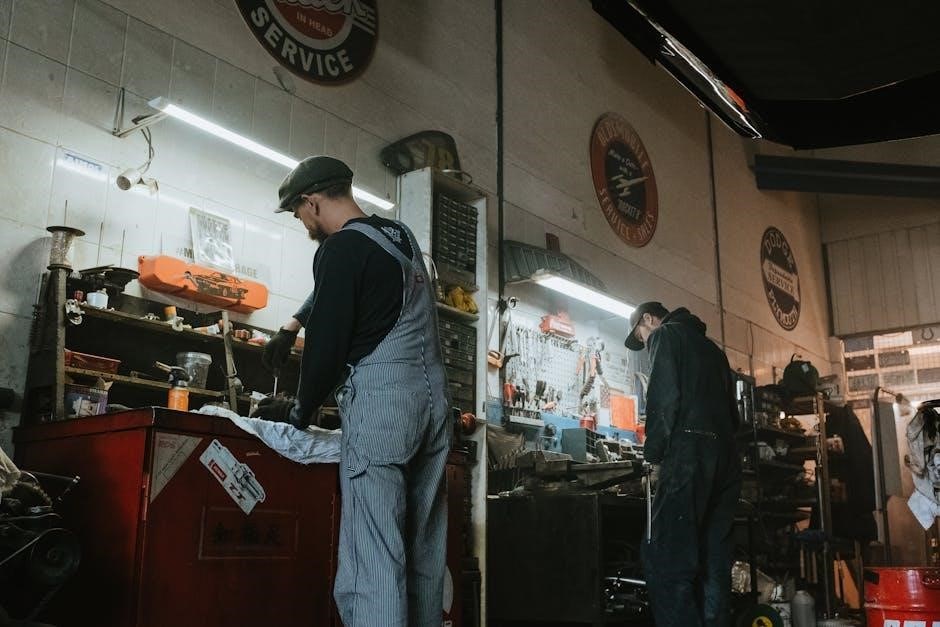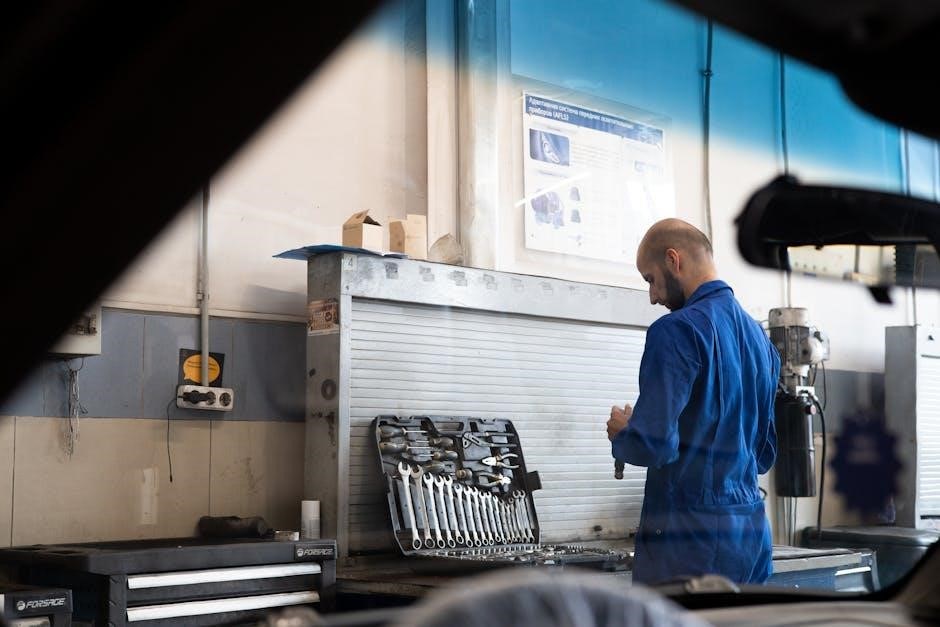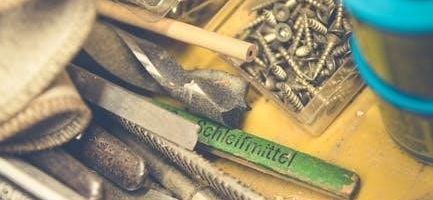Auto body repair tools and equipment are essential for restoring vehicles to their original condition. From hand tools to heavy-duty machinery, these resources ensure precise, safe, and efficient repairs.
Overview of Auto Body Repair
Auto body repair involves restoring damaged vehicles to their original condition, focusing on structural integrity, appearance, and safety. It encompasses various techniques, from dent removal and metalworking to refinishing and painting. The process requires precision tools, specialized equipment, and skilled technicians. Modern advancements in materials and technologies have expanded repair capabilities, ensuring efficient and high-quality outcomes. Proper training and adherence to safety protocols are crucial in this field, which continues to evolve with automotive innovations and environmental considerations;
Importance of Proper Tools and Equipment
Proper tools and equipment are vital for ensuring structural integrity, precision, and safety in auto body repair. They enable technicians to handle various repair tasks efficiently, from metalworking to refinishing. Using the right tools prevents further damage, saves time, and ensures high-quality outcomes. Without proper equipment, repairs can be challenging, and the overall quality and longevity of the repair may be compromised. Investing in quality tools and equipment is essential for a successful and professional auto body repair shop.
Essential Hand Tools for Auto Body Repair
Essential hand tools include wrenches, pliers, hammers, and measuring tools, which are vital for performing precise tasks in auto body repair, ensuring efficiency and safety.
Wrenches and Sockets
Wrenches and sockets are fundamental tools in auto body repair, enabling technicians to tighten, loosen, or remove bolts and fasteners efficiently. Combination wrench sets, available in both standard and metric sizes, are essential for versatility. Adjustable wrenches provide flexibility for varying bolt sizes, while impact sockets are durable for heavy-duty applications. Socket sets with ratchets and extensions enhance accessibility in tight spaces. Air-powered impact wrenches and drivers further streamline bolt removal processes. These tools are a cornerstone for any technician, ensuring precise and efficient repairs in auto body shops.
Pliers and Punches
Pliers and punches are indispensable for gripping, bending, and shaping metal components in auto body repair. Needle-nose pliers excel at reaching tight spaces, while slip-joint and locking pliers provide secure grips. Punches, such as center punches and pin punches, are crucial for marking and aligning holes or removing pins. These tools are essential for precise metalwork, ensuring accurate repairs and preventing damage to vehicle components. Their versatility makes them a must-have in every technician’s toolkit for handling intricate tasks efficiently;
Hammers and Dollies
Hammers and dollies are fundamental tools in auto body repair for shaping and smoothing metal surfaces. Ball-peen hammers are ideal for metal forming, while sledgehammers are used for heavier-duty tasks. Dollies, available in various shapes and sizes, provide support during hammering, preventing metal warping. These tools are essential for restoring vehicle panels to their original contours. Proper use ensures precise repairs, avoiding further damage. They are indispensable for metalwork repair, making them a cornerstone in every technician’s arsenal for achieving professional-grade results efficiently.
Measuring and Cutting Tools
Measuring and cutting tools are crucial for precision in auto body repair. Calipers and micrometers ensure accurate measurements, while air-powered saws and plasma cutters enable clean, precise cuts. These tools help technicians restore vehicles to factory specifications, ensuring proper fitment and structural integrity. They are essential for modifying or replacing parts effectively, making them indispensable for achieving professional-grade results in collision repair and restoration projects.

Specialized Tools for Auto Body Repair
Specialized tools for auto body repair are advanced equipment designed for complex tasks, ensuring precision and efficiency in restoring vehicles to their original condition safely.
Welding and Cutting Tools
Welding and cutting tools are essential for auto body repair, enabling technicians to join or separate metal components precisely. MIG and TIG welders are commonly used for sturdy, high-quality welds, while plasma cutters efficiently cut through metal. These tools are vital for restoring structural integrity and ensuring safety in repaired vehicles. Proper safety gear, like welding helmets and gloves, is crucial when operating this equipment. Their precision and reliability make them indispensable in professional auto body shops.
Dent Repair and Removal Tools
Dent repair and removal tools are specialized for restoring vehicle panels to their original shape. These include dent repair rods, hammers, dollies, and slide hammers, which help technicians contour and smooth out dents without damaging the surface. Precision is key, as these tools allow for careful manipulation of metal. Modern techniques, such as paintless dent repair (PDR), use specialized kits to remove dents without repainting. These tools are indispensable for achieving flawless results in auto body repair, ensuring vehicles look like new.
Paint Guns and Spray Equipment
Paint guns and spray equipment are crucial for achieving a smooth, high-quality finish in auto body repair. HVLP (High Volume Low Pressure) spray guns are commonly used for their efficiency and minimal overspray. Pneumatic and electrostatic sprayers ensure precise application, especially for metallic and pearl finishes. Proper setup and maintenance, including cleaning and tip replacement, are essential for optimal performance. These tools are vital for refinishing, ensuring durability and a professional appearance that meets industry standards and customer expectations in modern auto body shops.

Heavy-Duty Equipment for Auto Body Shops
Vehicle lifts, frame straightening systems, and wheel balancers are essential heavy-duty tools for auto body shops, enabling precise and safe repairs on modern vehicles.
Vehicle Lifts and Hoists
Vehicle lifts and hoists are essential for auto body shops, enabling safe and efficient access to underside components. Two-post and four-post lifts are common, with capacities ranging from 7,000 to 40,000 lbs. These lifts ensure proper vehicle stabilization, allowing technicians to perform repairs, inspections, and maintenance effortlessly. Heavy-duty models accommodate large trucks and SUVs, while smaller lifts are ideal for passenger vehicles. Advanced safety features, such as locking mechanisms and solid steel construction, guarantee reliability and operator confidence during lifting operations.
Air Compressors and Pneumatic Tools
Air compressors are crucial for powering pneumatic tools in auto body repair, enhancing efficiency and precision. They enable operations like sanding, cutting, and painting by delivering compressed air. Pneumatic tools, such as impact wrenches and air sanders, are essential for metalwork and surface preparation. Rotary screw and reciprocating compressors are common, offering reliable performance. Proper maintenance, including filter cleaning and oil checks, ensures longevity. These systems are indispensable for streamlining tasks and achieving professional-grade results in collision repair and refinishing processes.
Frame Alignment and Straightening Systems
Frame alignment and straightening systems are essential for restoring vehicles to their original structural integrity after collisions. These systems use hydraulic or mechanical force to realign bent frames, ensuring proper vehicle stability and safety. Advanced models feature electronic controls for precise adjustments. They are critical for collision repair shops, enabling technicians to return vehicles to manufacturer specifications efficiently. Proper training and safety protocols are vital when operating these powerful tools to avoid further damage or injury. They are indispensable for modern auto body repair, ensuring accurate and reliable frame restoration.
Diagnostic Tools for Precise Repairs
Diagnostic tools play a crucial role in modern auto body repair, enabling technicians to identify issues accurately and ensure precise, reliable repairs with advanced technology and data-driven insights.
Electronic Diagnostic Scanners
Electronic diagnostic scanners are indispensable in modern auto body repair, enabling technicians to quickly identify and troubleshoot complex vehicle issues. These tools connect to onboard diagnostics (OBD-II) systems, providing real-time data on engine performance, fault codes, and system malfunctions. Advanced scanners offer detailed analysis, guiding precise repairs and minimizing guesswork. They are essential for ensuring safety, efficiency, and compliance with manufacturer standards, making them a cornerstone of professional auto body shops and collision repair facilities. Their use streamlines the diagnostic process, reducing repair time and costs.
Alignment and Wheel Balancing Tools
Alignment and wheel balancing tools are critical for ensuring proper vehicle handling and safety. These tools help technicians detect and correct issues like uneven tire wear and misalignment. Modern digital wheel balancers and alignment systems provide precise measurements, enabling accurate adjustments. Proper alignment ensures even tire wear, improves fuel efficiency, and enhances overall vehicle performance. These tools are essential for maintaining vehicle stability and preventing premature wear on suspension and steering components, making them a vital part of any auto body repair shop’s equipment arsenal.
Paint Mixing and Matching Systems
Paint mixing and matching systems are essential for achieving precise color accuracy in auto body repair. These systems use advanced technology, such as digital color matching and spectrophotometers, to ensure a perfect match with the vehicle’s original paint. They include bases, toners, and clear coats, allowing technicians to mix custom colors efficiently. Modern systems also offer eco-friendly options, reducing waste and environmental impact. Accurate paint matching enhances the vehicle’s appearance and ensures a professional, factory-like finish, making these tools indispensable for collision repair shops.

Safety Equipment and Protective Gear
Safety equipment and protective gear are crucial for preventing injuries in auto body repair. Gloves, goggles, respirators, and steel-toe boots protect technicians from chemicals, debris, and physical hazards.
Personal Protective Equipment (PPE)
Personal Protective Equipment (PPE) is essential for safeguarding technicians during auto body repair. Common PPE includes gloves, safety glasses, face shields, and respirators to protect against chemicals, dust, and debris. Steel-toe boots prevent foot injuries from heavy tools or falling objects. Hearing protection is also vital in noisy environments. Proper PPE ensures compliance with safety standards and minimizes workplace hazards. Always use high-quality, industry-rated gear to maintain optimal protection and comfort throughout the repair process.
Ventilation and Fume Extraction Systems
Ventilation and fume extraction systems are critical for maintaining a safe working environment in auto body repair shops. These systems remove harmful fumes, dust, and particles from the air, reducing health risks and improving air quality. Advanced technologies, such as activated carbon filters and HEPA systems, are commonly used to trap contaminants. Proper ventilation also prevents the buildup of flammable vapors, ensuring compliance with safety standards and enhancing overall workshop efficiency. Invest in robust systems to protect technicians and maintain a clean, hazard-free workspace.
Consumables and Materials for Auto Body Repair
Consumables and materials, such as adhesives, sealants, fillers, sandpaper, and paints, are essential for ensuring durability and a professional finish in auto body repair.
Adhesives and Sealants
Adhesives and sealants are crucial materials in auto body repair, ensuring strong bonds and preventing leaks. They are used for bonding panels, sealing joints, and protecting against corrosion. Structural adhesives provide high-strength bonds for metal and composite materials, while epoxy-based compounds are ideal for filling gaps. Silicone sealants, known for their flexibility, are commonly used around windows and doors. Choosing the right adhesive or sealant depends on the repair type, material compatibility, and environmental conditions. Proper application and surface preparation are essential for durability and long-lasting results.
Fillers and Body Filler Materials
Fillers and body filler materials are essential for smoothing and repairing surfaces in auto body repair. Polyester-based fillers are commonly used for metal repairs, offering strong adhesion and quick hardening. Epoxy-based fillers provide superior durability and are ideal for larger areas. Lightweight fillers are designed for minor dents and scratches, while plastic fillers are suitable for flexible surfaces. Proper application, including surface cleaning and thin layering, ensures a smooth finish. These materials are sanded and painted over to achieve a seamless repair, restoring the vehicle’s original appearance and structural integrity.
Sandpaper and Abrasives
Sandpaper and abrasives are fundamental in auto body repair for smoothing surfaces, removing imperfections, and preparing areas for painting. Aluminum oxide sandpaper is commonly used for metal and wood, while silicon carbide is ideal for plastic and primer. Various grit levels, from coarse to fine, ensure proper surface preparation. Wet or dry sanding techniques prevent dust and improve finish quality. Abrasives like scuff pads and sanding blocks help detail small areas. Proper sanding enhances paint adhesion and ensures a seamless, professional-quality repair, making it a critical step in the auto body repair process.
Paints and Coatings
High-quality automotive paints and coatings are essential for achieving a durable, factory-like finish in auto body repair. Acrylic and urethane-based paints are commonly used for their durability and color retention. Primers and sealers prepare surfaces for painting, ensuring proper adhesion and corrosion protection. Clear coats add a protective layer, enhancing gloss and UV resistance. Advanced color matching systems help technicians replicate original vehicle colors accurately. These products are crucial for restoring vehicles to their original appearance, making them a vital component in every auto body repair process.

Training and Education in Auto Body Repair
Formal education and hands-on training are crucial for mastering auto body repair. Institutions like UTI offer comprehensive programs, equipping technicians with skills to use industry-standard tools effectively.
Certification Programs
Certification programs in auto body repair validate technicians’ skills and knowledge, ensuring they meet industry standards. These programs, offered by institutions like UTI, cover hands-on training with tools like welders, sanders, and diagnostic scanners. Certifications demonstrate expertise in collision repair, refinishing, and specialized techniques. They also provide access to better job opportunities and higher salaries. By completing these programs, technicians stay updated on new technologies and materials, enhancing their ability to perform precise and safe repairs. Certifications are essential for career advancement in the automotive repair field.
Hands-On Training Resources
Hands-on training resources provide practical experience with auto body repair tools and equipment. These resources include workshops, online tutorials, and practice manuals. Many programs, like those offered by UTI, emphasize real-world application of tools such as welders, sanders, and diagnostic scanners. Training resources often cover repair techniques, safety protocols, and material handling. They equip technicians with the skills needed to work efficiently in modern auto body shops. Access to these resources ensures technicians are well-prepared for the demands of the industry and can apply their knowledge effectively.

